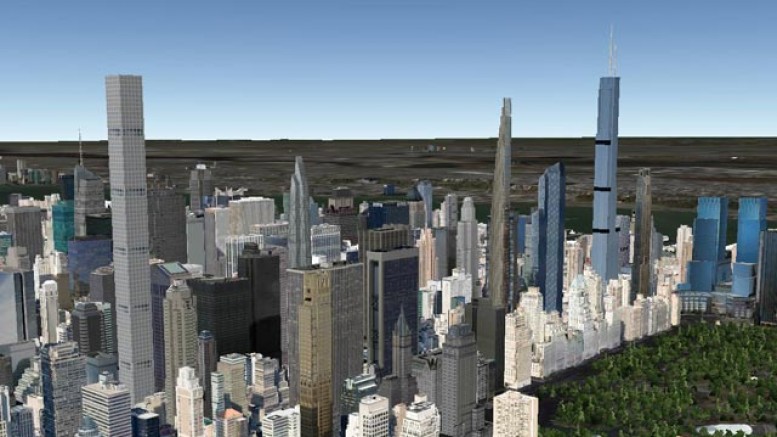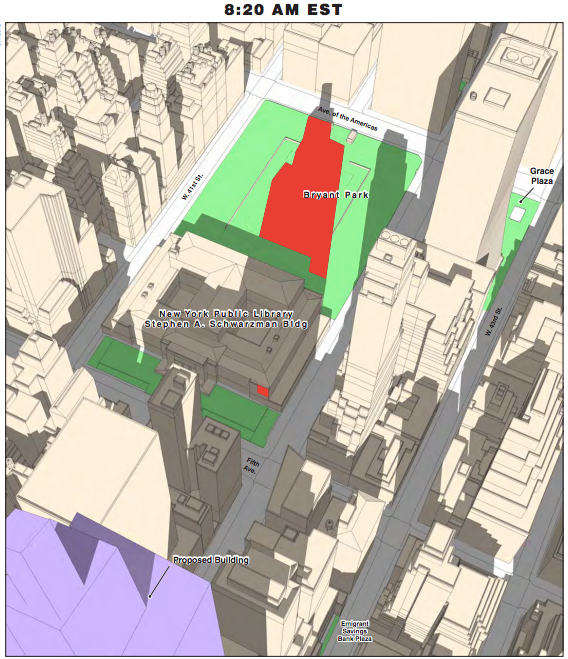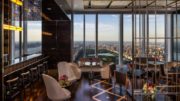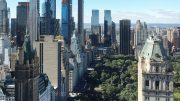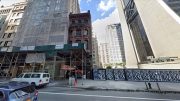The issue of shadows over Midtown had seemingly been settled over a century ago, with the construction of the neighborhood’s first skyscrapers, but many of the new trees in New York’s urban forest will stand a substantial height taller than the existing plateau. While critics have lurked in the background since the death of the original Torre Verre, they are once again out in full force, seeking new limitations on development due to “the shadows.”
In fact, Central Park has been affected by man-made shadows ever since its southern, eastern, and western peripheries began sprouting high-rise buildings, beginning around 1900. But with Midtown now covered in a plateau of 750-foot tall buildings, the debate seems more ridiculous today than it ever has.
Perhaps it is because some politicians are misinformed. YIMBY recently discussed the matter on Twitter with Mark Levine of the City Council, who is also Chair of the Council’s Parks Committee. He tweeted that we must “be thoughtful about where is right for growth. Some areas should be upzoned, some preserved,” which was followed up by “The Council is actually considering a major upzoning around Grand Central. But that won’t block sun in parks.”
Mark Levine must not be aware of One Vanderbilt, the proposed building coming to 42nd Street and Vanderbilt Avenue, which was allowed to be built as an early taste of the eventual Midtown East rezoning. The new supertall tower will most certainly cast fresh shadows, and in fact, an impact study conducted by the city shows One Vanderbilt’s shadows covering half of Bryant Park during certain mornings of the year.
What’s more glaring than Levine’s ignorance about his own supposed area of expertise is the enormous impact One Vanderbilt will have on buildings, landmarks, and parks across several neighborhoods, with evening shadows extending all the way to Roosevelt Island.
Of course none of this is actually bad, and shadows are inherent to the urban fabric of a city. But Manhattan is a unique case, and Midtown is the densest business district in the world. The impact of new 1,500-foot tall towers already in the development pipeline show how efforts to stop the 57th Street towers are really just political pandering against easy targets (and fortunately, One Vanderbilt was approved by the City Planning Commission last month, though it must still pass a few additional votes).
While Mark Levine is off making blatantly incorrect statements on Twitter, Councilman Ben Kallos is even worse, attacking a new 900-foot tower coming to Sutton Place because “it’s creating a future where the only people that will have a right to light and air are the people who can afford it.” He also added, “This is literally about the one percent having light and air, and the rest not.”
Ben Kallos represents Manhattan’s District 5, which includes both Sutton Place and much of the Upper East Side. It is literally covered in high-rise residential towers, with most of its homes already occupied by people in the 1%, with a median household income that’s well into the six figures.
In fact, the block that 426 East 58th Street would rise on is already so dense that it has its very own Census block grouping, which provides data regarding its inhabitants. As of 2010, the existing population of 650 households had an average income of $171,195, and 291 of those 650 homes had an income in excess of $200,000.
The notion that all development must cater to all income ranges is as absurd as the idea that Sutton Place isn’t already a bastion for the uber-wealthy, where money isn’t already a necessity for light and views. The reality of living in the home of the skyscraper, in the densest central business district on the planet, is that sometimes there are shadows, and that if there is a new building, rich people will probably live in it (and they will already most certainly live around it).
The fact that members of the City Council are wasting air on this debate when the affordability crisis is looming larger than ever is just another sign that the city’s political system is horribly incapable of solving its current problems, and an example of this kind of political action from the late 2000s shows just how little progress New York has made on this front of stupidity.
YIMBY detailed the Torre Verre saga in a post several years ago, but the crux of the issue was that rich people living on 53rd Street did not want a supertall in their supposedly “mid-rise” neighborhood. In the time since Amanda Burden caved to their demands, four buildings substantially taller than the original Torre Verre (1,250′) have either been completed or begun construction in surrounding blocks. The decision to turn the tower into a stump was made on the basis that its design didn’t merit sharing the same “rarified” air as the 1,250-foot tall Empire State Building.
Six years later, the political climate is just as toxic. Instead of focusing on the key issues that are affecting New York City, which partially stem from the short-sighted planning of the Burden years, politicians hone in on easy targets that can produce political capital at minimal cost. And unless New Yorkers stop voting for opportunists like Levine and Kallos, the situation in another six years won’t be any different.
For any questions, comments, or feedback, email [email protected]
Subscribe to YIMBY’s daily e-mail
Follow YIMBYgram for real-time photo updates
Like YIMBY on Facebook
Follow YIMBY’s Twitter for the latest in YIMBYnews

